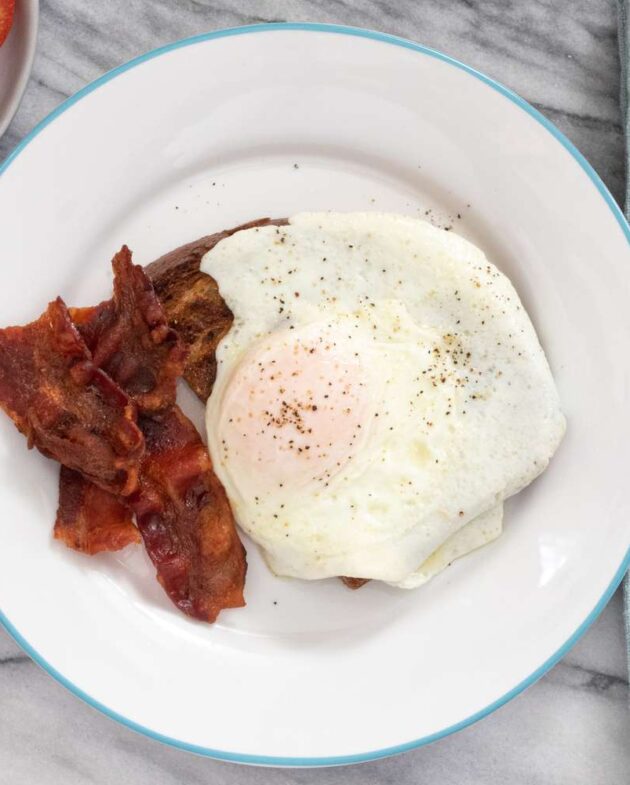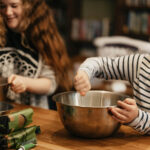- Calories:500 kcal
- Protein:32 g
- Carbohydrates:220 mg
- Sugar:300 mg
- Salt:51 g
- Energy:2092 kJ
- Fat:36 g
A frittata is an excellent egg dish—similar to a quiche without the crust (which makes it gluten-free)—that isn't just for breakfast or brunch. The frittata makes a satisfying lunch or dinner dish as well. And you don't have to dirty a lot of dishes and utensils to make a frittata. All you need are a few measuring utensils, a bowl and whisk for the eggs, and a 10-inch oven-safe cast-iron or nonstick skillet.
A classic frittata is infinitely adaptable and bakes in as little as 8 minutes, so it's important to sauté any vegetables and meat before adding the eggs. This one includes asparagus, ham, Gruyére cheese, and a few cherry tomatoes. Still, you could just as easily swap out the asparagus for broccoli or Broccolini or omit the ham and add another vegetable, such as thawed frozen peas or sautéed mushrooms. Or use cheddar cheese in place of the Gruyére. Be sure to check out the variations for some alternative combinations.
Serve a frittata with a salad, sliced fresh fruit, or fresh vegetables, or serve it with a cup or bowl of soup for a filling, well-balanced lunch or dinner.
Tips
- To streamline a breakfast frittata, chop the vegetables the night before and refrigerate them in separate containers.
- If your frittata looks a little plain, gussy it up with a dollop of sour cream, some fresh chopped tomatoes, fresh herbs, salsa, or a drizzle of homemade pesto.
- If you like a browned top, place the baked frittata under the broiler for a minute or two, just until browned.
Recipe Variations
Here are some alternative combinations using the basic seasoned egg mixture:
- Broccoli, Cheddar, and Bacon Frittata: Sauté 1/3 cup of minced shallots and 1 clove of minced garlic in 1 tablespoon of olive oil until the shallot is softened, about 4 minutes. Add 1 1/2 cups of chopped broccoli florets and continue to cook for about 1 minute, until just tender. Add the egg mixture and 4 ounces of shredded cheddar cheese, and about 1/4 to 1/2 cup of crumbled cooked bacon.
- Italian Sausage, Mushroom, and Parmesan Cheese Frittata: Brown 8 to 12 ounces of bulk Italian sausage in the skillet until fully cooked. Remove the sausage from the pan and drain well. In the same pan, sauté 1/3 cup of chopped shallots or onions with 6 to 8 ounces of sliced mushrooms for about 5 to 7 minutes, until the mushrooms have released their liquid and the liquid has evaporated. Add the drained cooked sausage back to the pan. Pour the egg mixture over the sausage and mushroom mixture, and then add 1/4 cup of Parmesan cheese along with about 1/4 cup of fresh chopped basil. Top with a thinly sliced tomato or several strips of roasted red bell pepper, and then sprinkle with another tablespoon of Parmesan cheese.
- Spinach and Feta Frittata: Sauté 1/2 cup of diced onion in 1 tablespoon of olive oil until translucent, about 5 minutes. Add 4 to 5 ounces of baby spinach to the pan and continue to cook for about 3 minutes—until the spinach is wilted and liquids have evaporated. Add 1 tablespoon of chopped fresh dill to the egg mixture. Pour the egg mixture over spinach and onions and sprinkle with 1 cup of drained and crumbled feta cheese.
- Vegetarian-Friendly Spring Vegetable Frittata: Omit the ham and add 1/2 cup of thawed frozen peas to the frittata when you add the cheese.
How to Store and Reheat
- Refrigerate leftover frittata in a covered shallow container within 2 hours and eat within 3 days.
- To reheat leftover frittata, preheat the oven to 350 F and place the frittata slices in an oven-safe dish or pan. Cover the pan tightly with foil and heat the frittata for about 20 minutes, or until it registers 165 F in the center of the thickest slice.
What is the Difference Between an Omelet and a Frittata?
Omelets and frittatas have some similarities—both are made with eggs and various ingredients, which may or may not include vegetables, meats, and cheese. A frittata might serve one or several people and is started in an open skillet on the stovetop and finished in the oven. A frittata may be served hot or at room temperature. An omelet is typically cooked for one in a skillet on the stovetop and is served hot.
Do You Flip a Frittata?
You don't have to flip a frittata—you can finish it in the oven and brown it under the broiler if you like. Flipping does have its advantages—lighter texture and more uniform browning—but it can be challenging if you don't have a specialty pan.










